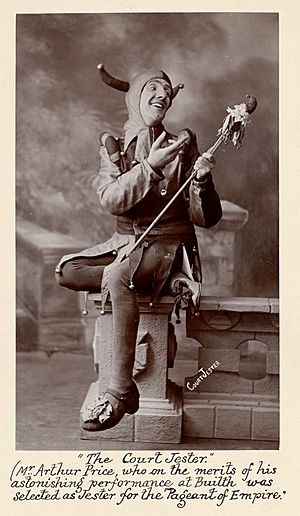Pageant of Empire facts for kids
The Pageant of Empire was a series of big shows held in Britain in the early 1900s. These shows celebrated the history of the British Empire. Think of them like huge plays or parades!
For example, a smaller pageant happened in Builth Wells in 1909. A much bigger one took place in 1911 at the Festival of Empire at the Crystal Palace in London. Thousands of people acted out historical events there.
The most famous Pageant of Empire happened in London in 1924. It was a truly massive event!
Contents
The London 1924 Pageant of Empire
The biggest and most detailed pageant was held in London in 1924. It was part of the huge British Empire Exhibition. This exhibition took place at the Empire Stadium, which later became Wembley Stadium.
The pageant was directed by a man named Frank Lascelles. It was performed from July 21 to August 30, 1924. Its full name was The Pageant of Empire: An Historical Epic.
What made the 1924 Pageant so big?
This pageant was truly enormous! It had a cast of 15,000 people. Imagine that many actors!
It also featured many animals. There were 300 horses, 500 donkeys, and 730 camels. Plus, 72 monkeys, 1000 doves, seven elephants, three bears, and even one macaw bird!
The entire show was so long that it took three days to watch all of it.
The Music and Scenery
The music for the pageant was chosen by Henry Jaxon and Ignatius de Orellana. A large orchestra of over a hundred musicians played. These musicians came from three different London orchestras.
There was also a huge choir. The singers were from local groups and volunteered their time for free. The beautiful scenery for the show was designed by Frank Brangwyn.
What stories did the Pageant tell?
The pageant showed many different historical stories. Some parts focused on famous British history. For example, there was a section about "The Days of Queen Elizabeth". Another part showed "The English Fleet in the Mediterranean", featuring Admiral Blake and the Barbary Pirates.
There was also a section about George III and when Captain Cook began his famous voyages. A special part was called "A Pageant of Heroes", celebrating important figures.
Celebrating the Empire's Countries
The pageant also had sections for different countries of the British Empire. These included South Africa, India, New Zealand, and Australia.
For each of these country sections, the first musical piece was a poem by Alfred Noyes. This poem was set to music by the famous composer Edward Elgar.
Many other British composers had their music featured too. These included Eric Coates, Edward German, Percy Fletcher, Samuel Coleridge-Taylor, and Arthur Sullivan.
The Final Acts
The pageant ended with two special parts. One was "A Pageant of Heroes". The other was "An Empire's Thanksgiving".
For "A Pageant of Heroes", poems by Alfred Noyes and Laurence Binyon were set to music by Elgar. For "The Empire's Thanksgiving", a poem by Laurence Binyon was set to music by Nicholas Gatty. There was also a reading of "Recessional" by Rudyard Kipling, set to music by Herbert Bunning.
Elgar's Contributions
Sir Edward Elgar was a very important composer for the pageant. Three pieces from his work "The Crown of India" were used in the section about "The Early Days of India."
Elgar also wrote a set of songs called Pageant of Empire for the event. These songs used words by Alfred Noyes. Elgar himself conducted the choirs when the Exhibition first opened. His famous song Land of Hope and Glory was performed then.
Elgar also composed his Empire March for this special occasion. However, his older Imperial March was performed instead.
See also



